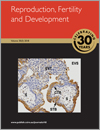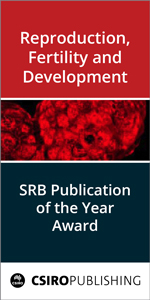Reproduction, Fertility and Development
Volume 30
Number 3 2018
Ovum pick-up and in vitro embryo production can be used in dairy heifers. However, production results are often disappointing when animals are underfed. A short-term dietary supplement with propylene glycol (400 mL of PG or water/drench, daily drenching at 1600 hours for the first 9 days of the oestrous cycle), given to feed-restricted heifers, was able to restore the expression of selected genes in cumulus cells and blastocysts to levels seen in correctly fed heifers.
Reduced fetal growth can contribute to a greater risk of later metabolic disease, but the key mechanisms remain unknown. Herein we report findings from a large animal model (sheep) in which fetal growth was restricted by reducing maternal food intake and show that once the offspring become obese, they exhibit increased abundance of molecular markers of metabolic stress in the fat and liver. This could represent a primary mechanism by which growth-restricted offspring are at greater risk of metabolic ill health in later life.
Humans may be exposed to 2,3,7,8-tetrachlorodibenzo-p-dioxin (TCDD), an environmental pollutant, via contaminated food, inhalation or skin contact. The effects of TCDD are exerted via binding to aryl hydrocarbon receptors (AhR). In this study we investigated the possible protective effect of resveratrol, an AhR antagonist, against testicular damage caused by TCDD exposure during pregnancy. The findings suggest that TCDD in combination with resveratrol results in more severe toxicity than administration of either drug alone.
Intracytoplasmic sperm injection (ICSI) has been successfully applied to hybrid mice, but not to inbred mice due to low efficiency. Adding an activation step to ICSI of oocytes from juvenile mice results in the birth of healthy inbred pups. The results of this study show that the modified protocol can potentially improve the efficiency of ICSI in inbred mice.
For wild rodents such as the agoutis, the combination of gonadal tissue cryopreservation and xenotransplantation could help promote germplasm conservation and reproduction, especially in the case of genetically valuable individuals. The present study demonstrates that xenografted agouti ovarian tissue, fresh or vitrified, is able to promote the return of ovarian activity in ovariectomised SCID C57B1/6 mice.
Tumor suppressor protein p53, known widely as the guardian of genome preventing cancer formation, is also involved in physiological apoptosis of germ cells in testes. The study used a mouse model to reveal that germ cell apoptosis during the first round of spermatogenesis can be efficiently mediated by p53-independent mechanisms, but activation of these mechanisms requires engagement of multicopy Y-chromosome long arm genes. The role of Y-chromosome genes in regulation of testicular apoptosis was demonstrated for the first time.
A major limitation of IVF success is failure of the embryo to successfully attach to the womb. We have identified a critical new mechanism of communication between the human embryo and endometrium (inner lining of the uterus). Overall it is likely that this bi-directional communication facilitates the critical adhesion process during the initiation of successful pregnancy.
One of the predominant causes of anoestrus is a low level of ovarian oestrogens. Herein, we investigated the association of the oestrogen biosynthesis regulator CYP19A1 with the risk of anoestrus in buffaloes and found three SNPs. The risk alleles in these SNPs were significantly associated with lower levels of estradiol and antioxidants and higher incidence of oxidative ovarian damage and anoestrus.
Genetic background can help to explain idiopathic cases of recurrent pregnancy loss (RPL), which make up about 50% of total cases. Here, we have evaluated the genetic profiles of women experiencing RPL by analysing polymorphisms in the NOS2, PTGS2 and VEGFA genes. We found a higher incidence of a polymorphic variant in the NOS2 gene in the RPL group, suggesting a role for this gene in RPL risk, possibly due to oxidative stress mechanisms.
The application of genome storage in conservation is severely constrained by our limited access to reliable assisted breeding techniques. This is particularly so for marsupials, in which the corpus luteum, and thus cycling, is not affected by agents used to control ovarian function in eutherian mammals. Herein we report progress on the use of a single-treatment long-acting suppressor of pituitary function to reset cycling and ovulation in a marsupial.
The placenta is a multifunctional link between mother and fetus vital for nutrient transport. In this study we determined when and where nucleobindin-2/nesfatin-1 were located in the placenta and found them particularly in secretory trophoblast cells of the mouse and human placenta. The placenta should be considered a source for nucleobindin-2/nesfatin-1 during pregnancy, with possible roles in maternal glucose control and nutrient sensing.
A prolonged inflammatory response to breeding severely decreases fertility in horses. The aim of the present study was to evaluate differences between fertile and subfertile mares in the expression of selected genes associated with the immune response. Three of the genes analysed proved to be very sensitive and specific diagnostic markers predicting prolonged inflammation, and likely reduced fertility, prior to breeding.
The types and copy numbers of very short so-called miRNA molecules were measured in eggs and embryos of cattle. Results highlight the importance of a non-canonical miRNA during stages before embryonic transcription begins, the influence of the parental origin of miRNAs and the importance of measuring absolute as opposed to relative levels of these molecules.
The testis-specific protein, Y-encoded, 1 (TSPY1) gene is a newly confirmed regulator of sperm production, and dosage deficiency of the multicopy gene confers increased risk of spermatogenic failure. The aim of the present study was to evaluate whether the autosomal homologous genes originating from TSPY1 modify the spermatogenic phenotype of TSPY1. The results suggest that phenotypic expression of TSPY1 defects is independent of variations TSPY-like 1 (TSPYL1) and TSPY-like 5 (TSPYL5), highlighting the significance of TSPY1 in the modulation of spermatogenic efficiency.
Some genes are involved in stallion semen tolerance to cryopreservation. This work evaluated the relationship between CRISP-3 protein and some of its single nucleotide polymorphisms, with post-thawing semen quality in stallions. This study demonstrated that different parameters of seminal quality are influenced by the CRISP-3 genotype and the concentration of this protein in seminal plasma.




